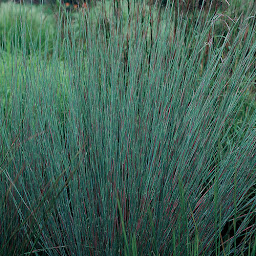
After the frost hits, the leaves and stems turn reddish. This helps it to flower and produce seed from July through September. Its deep root system keeps it going through drought. Hot, dry summers do not trouble little bluestem at all. It may even grow from rhizomes where soils are a little more moist. It starts growing in late spring, primarily from seed but also through the production of shoots (tillers). This species is a perennial warm-season plant. Little bluestem is considered to be adapted to USDA hardiness zones 3 through 9. It requires a soil pH of 7.0 or slightly higher. It can even tolerate the partial shade of open woods, as long as the soil is well drained. It can adapt quite well to poor soils, including those that are shallow, rocky, or low in fertility, and it can stand some salinity. Within its wide range, little bluestem is typically found on drier sites, particularly on top of ridges and hills. Because little bluestem is such an important prairie plant across all of Kansas, it was declared the state grass in 2010. It is the only native grass species that can be found in every Kansas county, as it is adapted to tallgrass, mixed, and shortgrass prairie ecosystems alike. Little bluestem can be found across most of the United States, where it is native, but it is particularly common in the Great Plains states of Kansas and Oklahoma. The fertile spikelet bears a unique hairy, curled awn which gives the entire seedhead a white, fuzzy appearance.īelow the ground, little bluestem boasts roots ranging from five to eight feet long. In each pair, one spikelet is fertile and the other sterile. The raceme of the little bluestem is one to three inches long and consists of spikelets growing in pairs on a flattened pedicel. The inflorescence is a single raceme, an arrangement in which the spikelets grow on a short stems called pedicels. Inside the sheath is a fringed membrane known as the ligule. The sheaths are short and typically smooth. They tend to feel a little rough to the touch near the sheath, but are smooth throughout the rest of their length. The blades may bend or roll backwards as they mature and taper to sharp points.

The leaves are less than 1/4 inch wide, but they vary from 2 to 12 inches in length. The upright, slightly flattened stems often branch. Although it shares the waxy bluish-green stem of the famous big bluestem plant, the more humble little bluestem ( Schizachyrium scoparium) has few other similarities in appearance.


 0 kommentar(er)
0 kommentar(er)
